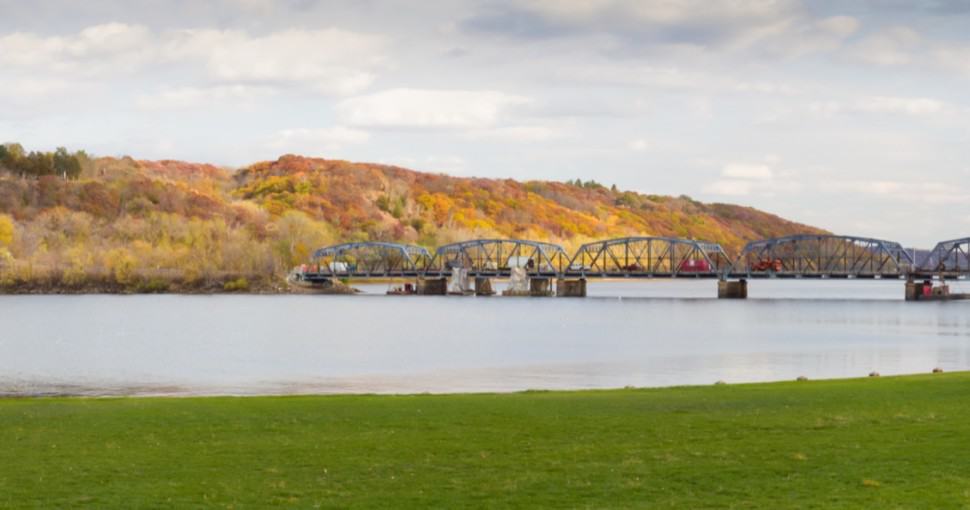Nearly 16 million acres of Wisconsin’s 35 million acres are forests. Forestland reportedly accounts for 46% of Wisconsin’s total land area. 52% of the woodlands are owned by private individuals. Hence, there is an abundance of diverse trees to be found, making Wisconsin’s woodlands an excellent site to look for various species.
Contents
- 1. Sugar Maple (Acer saccharum)
- 2. Ash Trees (Fraxinus)
- 3. White Oak (Quercus alba)
- 4. Balsam Fir (Abies balsamea)
- 5. Eastern White Pine (Pinus strobus)
- 6. Tamarack (Larix laricina)
- 7. Black Spruce (Picea mariana)
- 8. Northern Whitecedar (Thuja occidentalis)
- 9. Paper Birch (Betula papyrifera)
- 10. Jack Pine (Pinus banksiana)
- 11. Basswood (Tilia americana)
- 12. Aspen Trees (Populus tremuloides)
- 13. Boxelder Maple (Acer negundo)
- 14. Thuja (Arbor vitae)
- 15. Quaking Aspen (Populus tremuloides)
- 16. Green Ash (Fraxinus)
- 17. Thornless Honeylocust (Gleditsia triacanthos var. inermis)
- 18. Littleleaf Linden (Tilia cordata)
- 19. Weeping Willow (Salix alba ‘Tristis’ or Salix babylonica)
- 20. Crabapple Trees (Malus)
- 21. Flowering Plum (Prunus triloba)
- 22. Saucer Magnolia (Magnolia × Soulangeana)
- 23. Serviceberry (Amelanchier arborea)
- 24. Pagoda Dogwood (Cornus alternifolia)
- 25. Red Cedar (Juniperus virginiana)
In Wisconsin, deciduous trees and shrubs are those that shed their leaves on a seasonal basis. Hardwood trees are deciduous trees. These trees are notable for the moisture they produce throughout the growing season. This hydration is derived from Wisconsin’s as well as other Northern states’ rich soil. Oaks, Elms, Maples, and Ashes are the most frequent trees in the Northern states.
As the seasons change and the days become shorter, deciduous trees produce less chlorophyll pigment. The beauty of fall leaf color changes is brought forth by this phenomenon. When the days shorten and the nights cold but remain above freezing, the brightest leaf colors emerge.
In present-day Wisconsin, forestry is critical to the state’s economy as well as the locals’ general well-being. Wisconsin’s timber sector is the state’s second-largest employer. It is the state that produces the most paper, as well as the highest quality veneer and sawlogs. However, most critically, Wisconsin’s forests are maintained in such a way that its residents get the landscape, recreation, biodiversity, water quality, and scenic beauty they expect.
From maple and oak trees to pine and plum trees, you can find numerous species in Wisconsin’s forests. Here are some of the most common trees in the state:
1. Sugar Maple (Acer saccharum)
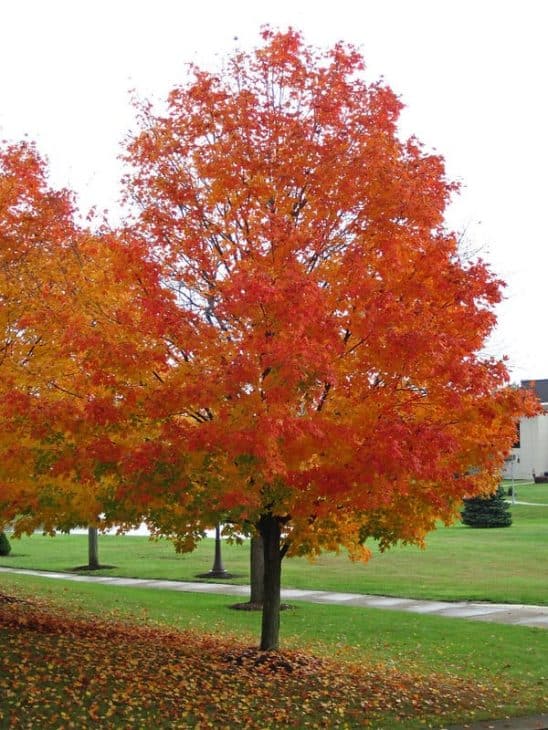
Sugar Maple, Wisconsin’s state tree, is one of the hardiest and long-lived maples. This tree is a hallmark of Wisconsin forests and fall colors, and is sought commercially in the timber and syrup industry. Sugar Maples are a wonderful sight in the fall, with colors varying from yellow to orange to crimson. The tree grows up to 50 to 75 feet and blooms with yellow flowers in April.
2. Ash Trees (Fraxinus)
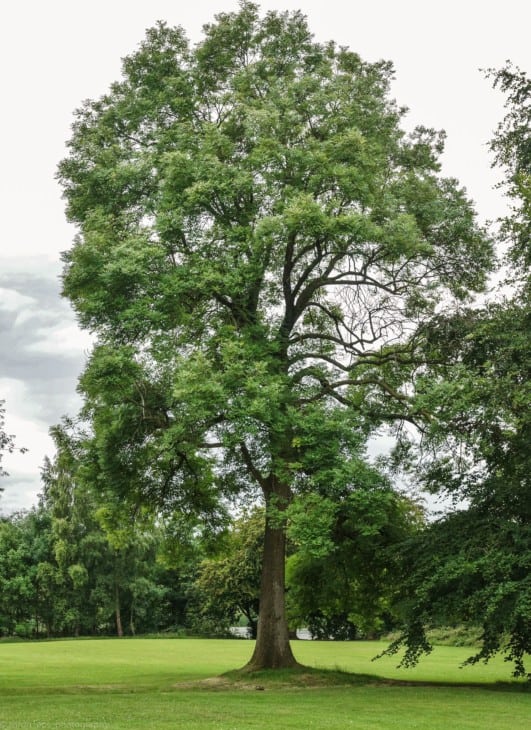
Green ash, black ash, white ash, and blue ash are the four native ash species in Wisconsin. These species’ horticultural varieties are widely cultivated in urban areas. Ashes are often resistant to urban conditions and have been widely established as street trees. Ash trees have not had many severe pest and disease concerns up until recently. They can be distinguished through their rough bark with diamond-shaped ridges.
3. White Oak (Quercus alba)
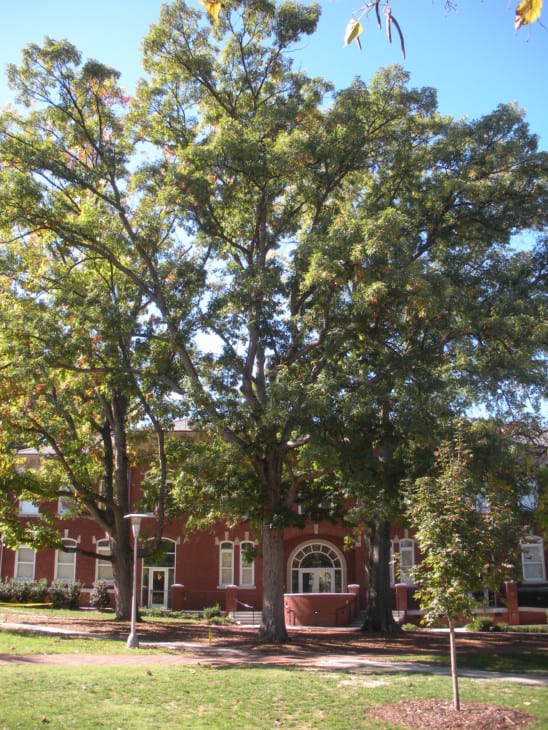
White Oak trees grow tall and straight, reaching heights of 60 to 100 feet. They have a wide-spreading, round crown with irregular, heavy limbs. The bark is scaly and pale gray. Its leaves remain on the tree throughout most of the winter and are light green from above with a paler underside. They bloom with yellowish-green flowers in May. It grows well in moist and slightly acidic, and alkaline soils.
4. Balsam Fir (Abies balsamea)
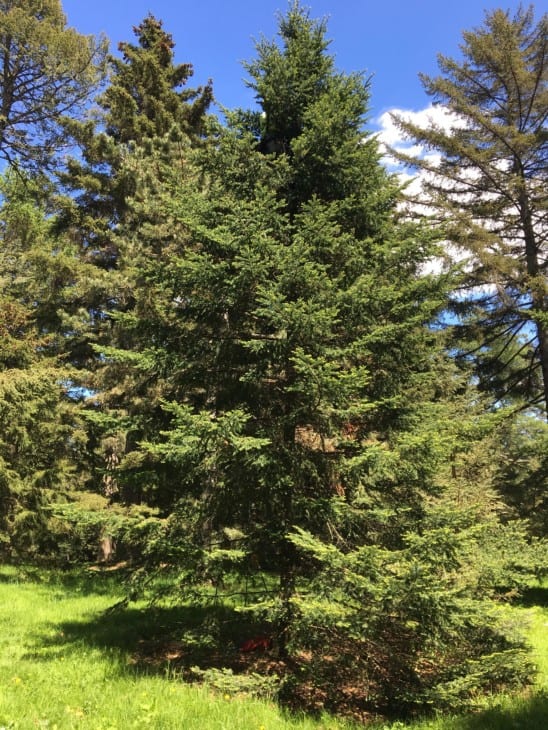
Balsam Fir trees are abundant in Wisconsin’s northern regions, growing as high as 40 to 60 feet. They have a smooth, grayish bark identifiable through blisters filled with balsam pitch or resin. The lustrous, dark green, needle-like leaves are fragrant. It can also be found in Michigan, Pennsylvania, New York, Connecticut, and other New England states. It blooms from September to October with yellow, green, brown, and purple flowers.
5. Eastern White Pine (Pinus strobus)
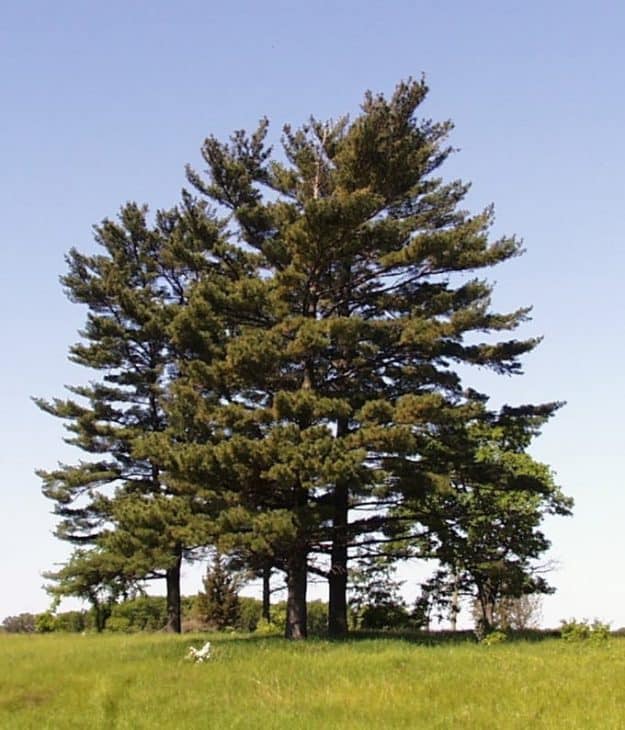
This attractive tree can be found growing in sandy, well-drained soils and along rocky ridges throughout Wisconsin. As one of the most impressive trees in the state, the white pine has a tall trunk and a lovely pyramid shape with delicate grey-green needles. It can reach a height of 100 feet. On young trees, the bark is thinner and greenish-gray, but on mature trees, the bark is grey, thick, and deeply carved.
6. Tamarack (Larix laricina)
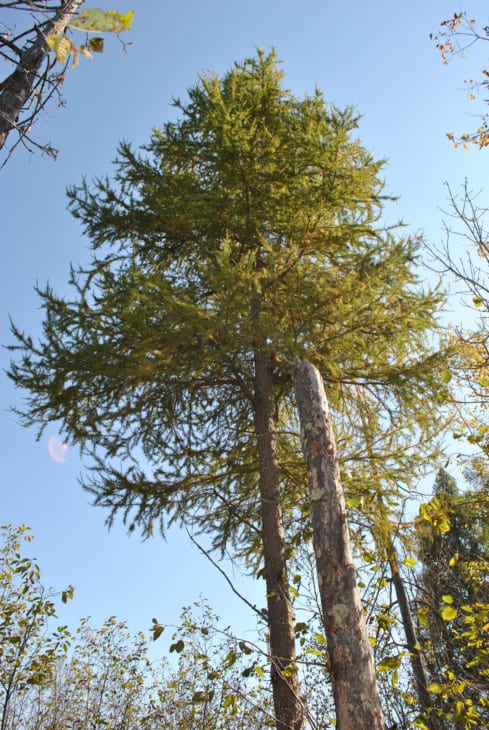
Tamarack trees have an open, pyramidical crown, which reaches up to 30 to 60 feet. The rough bark separates into thin, reddish-brown scales. Its dark green needles turn a dull yellow in the fall. It blooms in April with yellowish-white and pink flowers. In the U.S., it can be found in northeastern states from Minnesota to West Virginia and even in central Alaska.
7. Black Spruce (Picea mariana)
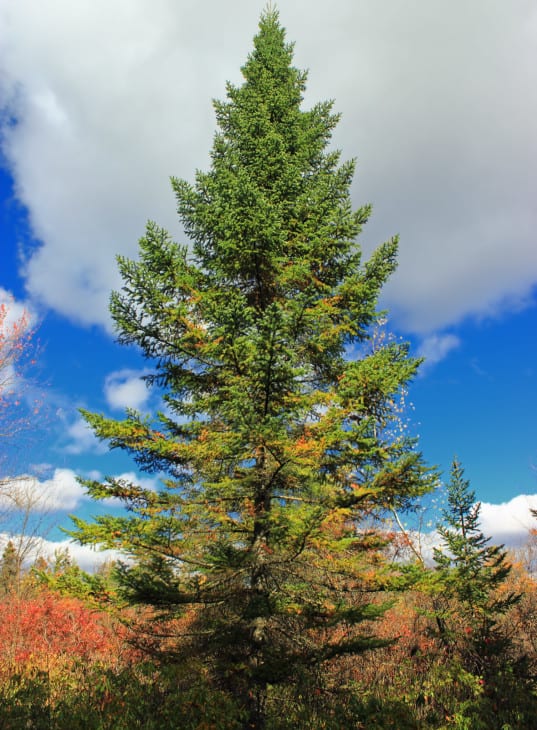
In Wisconsin, this small tree rarely exceeds 60 feet in height and 1 foot in diameter and is frequently a stunted tree just under 30 feet tall. With falling branches that reach close to the ground, the crown is dense and conical, and the bark is thin with gray-brown scales. In northern Wisconsin, it can be found in marshes with limited drainage and on well-drained slopes.
8. Northern Whitecedar (Thuja occidentalis)
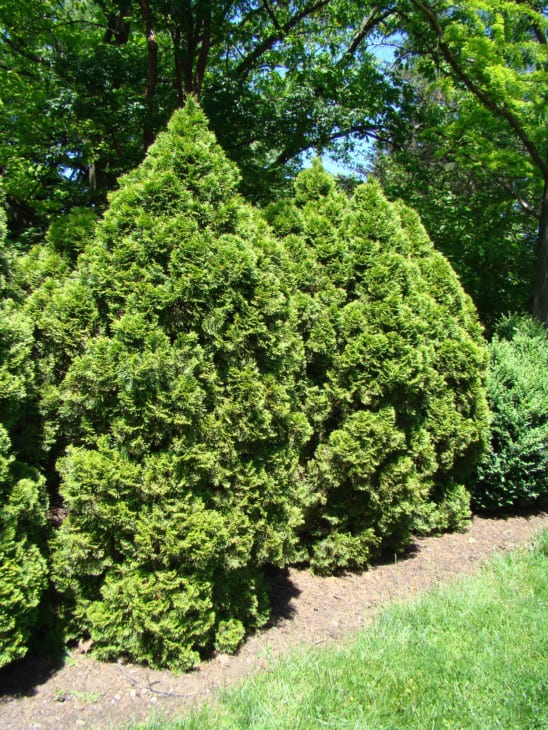
The Northern Whitecedar tree grows up to 50 to 60 feet tall, and its bark is gray to reddish-brown, thin, and separating in long, narrow shreddy strips. Its leaves have a pungent taste and an aromatic smell when crushed. It grows in moist places; however, it also grows on well-drained slopes and is found throughout most of the state, except in the southwest.
9. Paper Birch (Betula papyrifera)
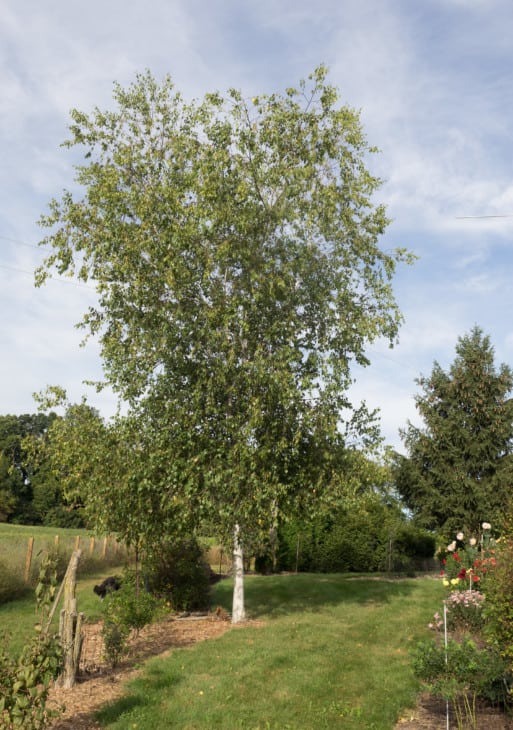
Paper Birch trees are abundant throughout Wisconsin, growing up to 65 to 70 feet with a pyramid-shaped crown. Its bark is its most distinguishing feature. On younger trees, it is smooth and reddish-brown, while mature trees turn creamy white. The bark has many pores and peels in large chunks to reveal its inner orange bark. Its leaves have a dark green upper surface and a pale yellow-green underside.
10. Jack Pine (Pinus banksiana)
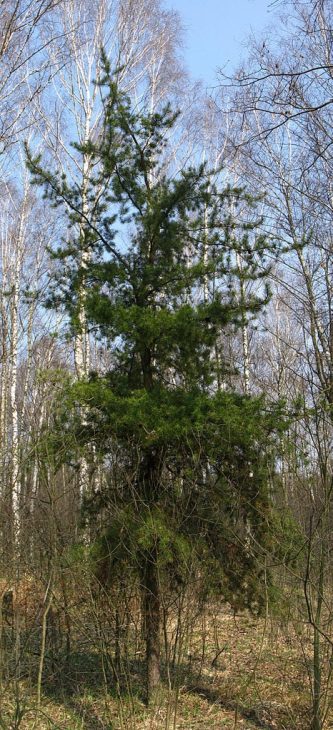
Jack Pine trees grow up to 50 to 70 feet, attaining a conical shape. Dead branches often stay on the trunk along the tree’s length. Furrows in its bark separate the dark brown scales into uneven tiny scales. It features sharp yellow to dark-green needles. It is prevalent on the sandy soils of the state’s northern region and stretching down to Wisconsin River, Iowa, and Grant counties.
11. Basswood (Tilia americana)
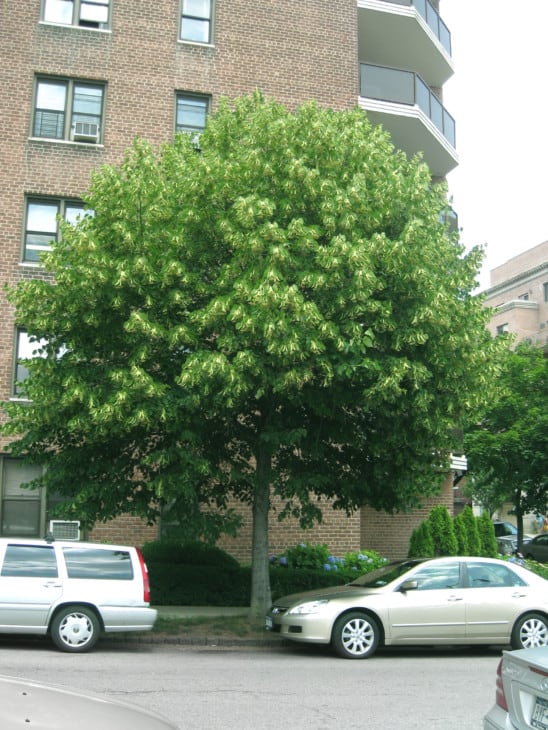
Basswood trees can attain a height of 60 to 80 feet with a dense crown and a gray bark with scaly ridges and shallow furrows. The leaves are heart-shaped and coarsely toothed, shiny from above and pale on the underside. It blooms in June with inconspicuous but fragrant flowers. Its native range extends from Canada to Michigan, Minnesota, Manitoba, North Dakota, Nebraska, Kansas, Oklahoma, Tennessee, North Carolina, Arkansas, and New Jersey.
12. Aspen Trees (Populus tremuloides)
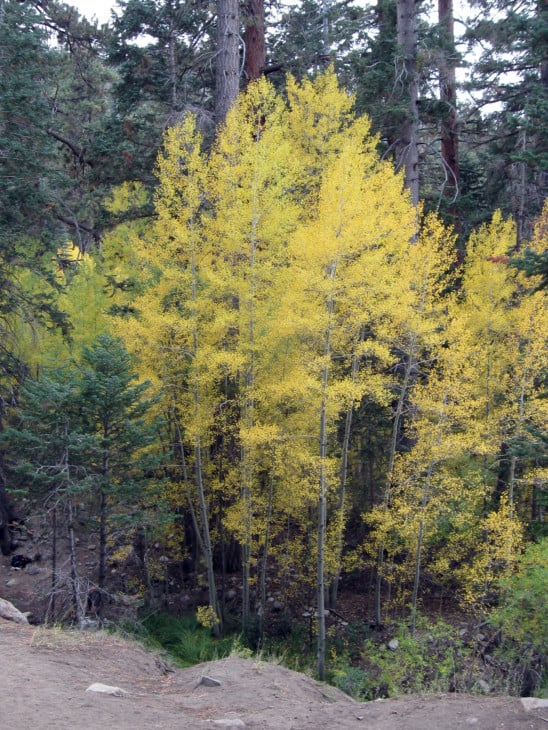
In northern Wisconsin, aspen forests make up a large portion of the forested terrain. Aspen is a “pioneer” tree that grows in groups that have been regenerated after a large disruption such as a devastating fire, clearcut, or harvest. Aspen outgrows many of its companion species. It is commonly referred to as ‘popple,’ and the Big-Toothed Aspen and Quaking Aspen are native to this region.
13. Boxelder Maple (Acer negundo)
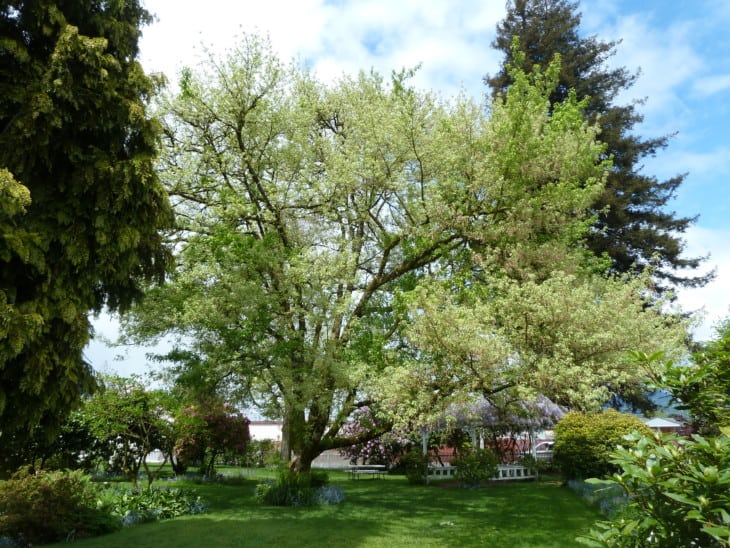
Boxelder Maple trees grow along streams and in cool ravines. Reaching a height of 30 to 50 feet, the Boxelder Maple has fragile limbs and branches with an unsymmetrical, open crown. The branches have a green to purple bark, while mature trees have thin, grayish-brown bark. Its yellow-green flowers bloom in spring. Its compound leaves turn a purple-green shade with change in season.
14. Thuja (Arbor vitae)
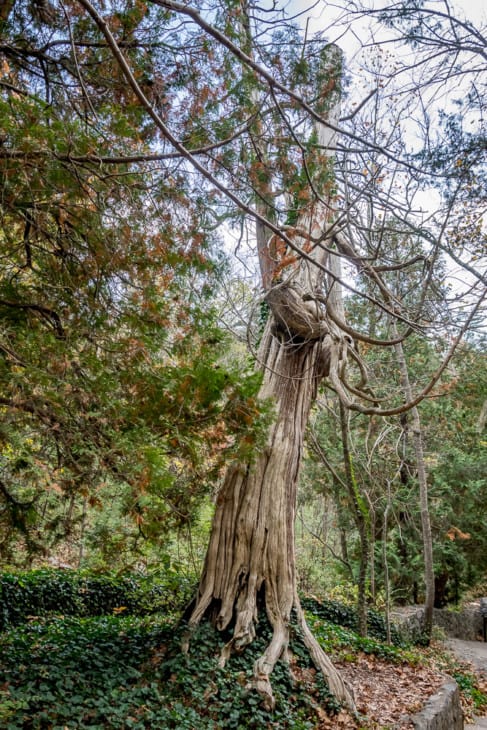
Thuja is an evergreen tree that grows up to 40 to 50 feet tall, easily recognized for its leaves. The leaves are tiny, scale-like, and cling to the branches firmly. The leaves are divided into two types: one that is flat and wide, and another that is folded and thinner. Around the middle of April, its flowers begin to bloom. It can also be found in Idaho, Alaska, Northern California, and British Columbia.
15. Quaking Aspen (Populus tremuloides)
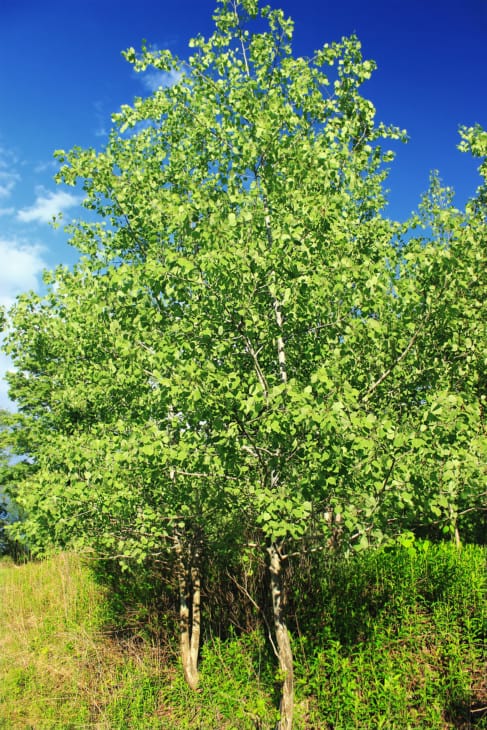
The Quaking Aspen is a short-lived tree with a height of 60 to 70 feet and a round crown. Its leaves are broad, oval, finely-toothed, and green. Thanks to their flat-leaf stalks, they quake in the slightest breeze. The bark is white to grayish-green and almost smooth, with black patches around the base of the branches. They are also commonly found in Colorado and Alaska.
16. Green Ash (Fraxinus)
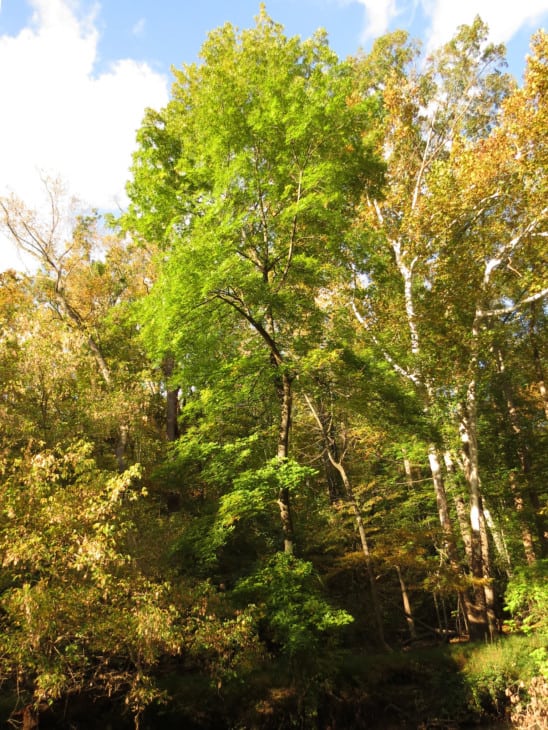
Green Ash has a thin trunk and a dense crown, growing to a height of 60 to 70 feet. As the tree looks for bright light, the trunk is commonly deformed. The bark is light grey to brown, and it is furrowed into interconnecting corky ridges in a diamond arrangement. The inner bark is a reddish-brown color. Twigs are a bright green color that fades to grey over time.
17. Thornless Honeylocust (Gleditsia triacanthos var. inermis)
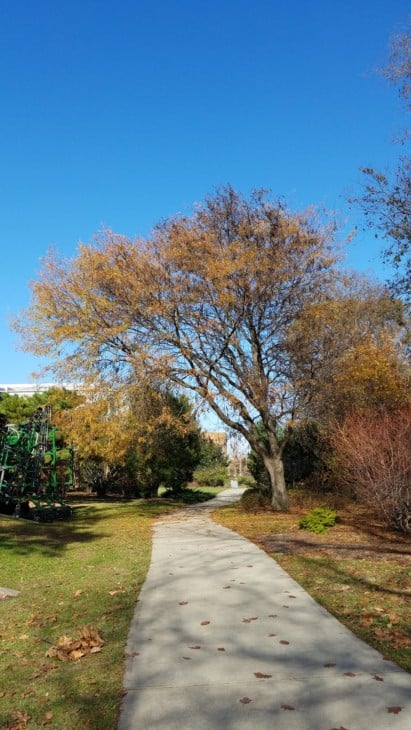
The Thornless Honeylocust grows up to 30 to 50 feet in fertile, well-drained soils and has a rather flat but broad and open-top crown. It has fragrant greenish-yellow spring flowers. Its tiny, green leaflets turn yellowish in the fall. Its native range lies from Pennsylvania and Nebraska to Texas. Its 7- to 8-inch-long pods contain a sweet, honey-like substance.
18. Littleleaf Linden (Tilia cordata)
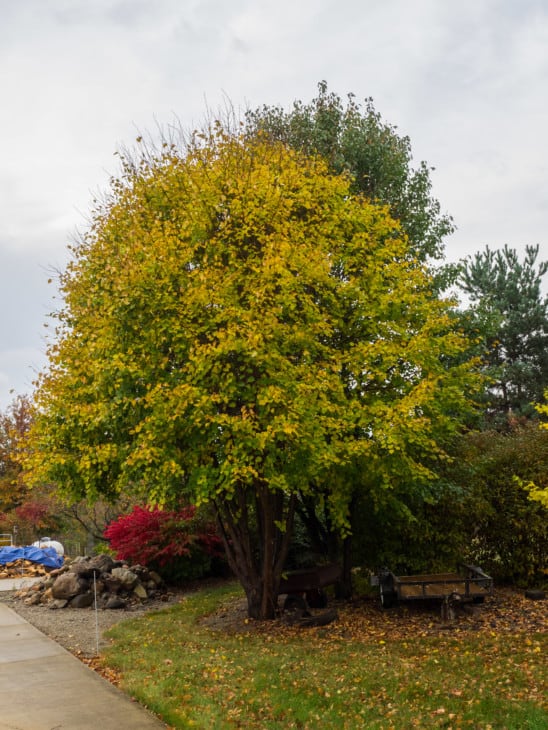
The Littleleaf Linden tree can grow up to 50 to 70 feet tall with a spread of 35 to 50 feet. The optimal soil for the Littleleaf Linden Tree is moist, well-drained loamy soil. The leaves turn a gorgeous golden-yellow color in the fall. In the right conditions, it can produce edible nuts. It blooms in June and July with cream-colored flowers.
19. Weeping Willow (Salix alba ‘Tristis’ or Salix babylonica)
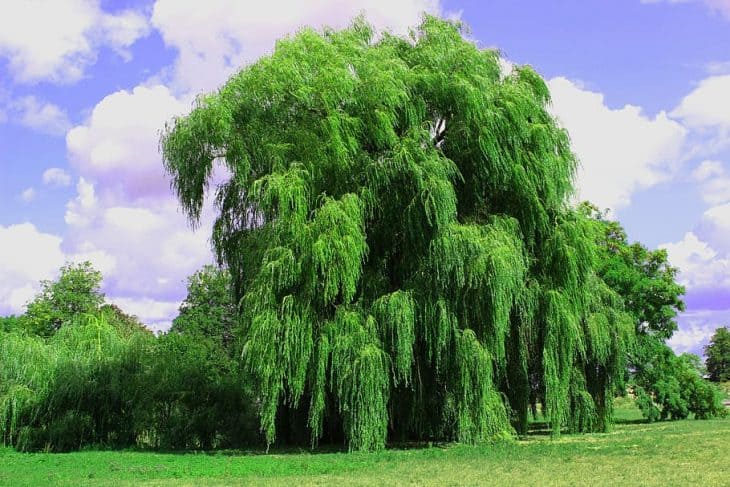
The Wisconsin Weeping Willow has short dark glossy-green leaves with brown or dull-green pendulous limbs. The willow tree is a simple plant to grow, requiring little to no attention or maintenance. The crimson color of the new wood contrasts with the green of the elder bark. The size of a mature tree is 40 to 60 feet tall and 50 feet wide. It is a heat-tolerant and cold-hardy plant.
20. Crabapple Trees (Malus)
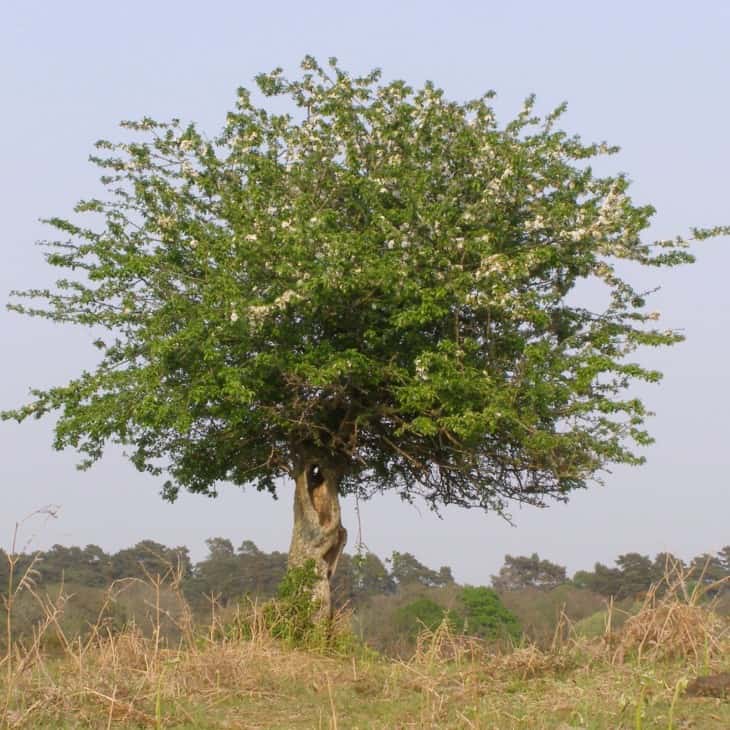
Crabapple trees are usually used as medium-sized ornamental trees in urban settings. Crabapples come in over 650 different varieties, each with its own set of leaf, blossom, and fruit colors, sizes, and growth styles. Crabapples may grow in a variety of soil types as long as they are adequately drained, and they usually have fragrant flowers.
21. Flowering Plum (Prunus triloba)
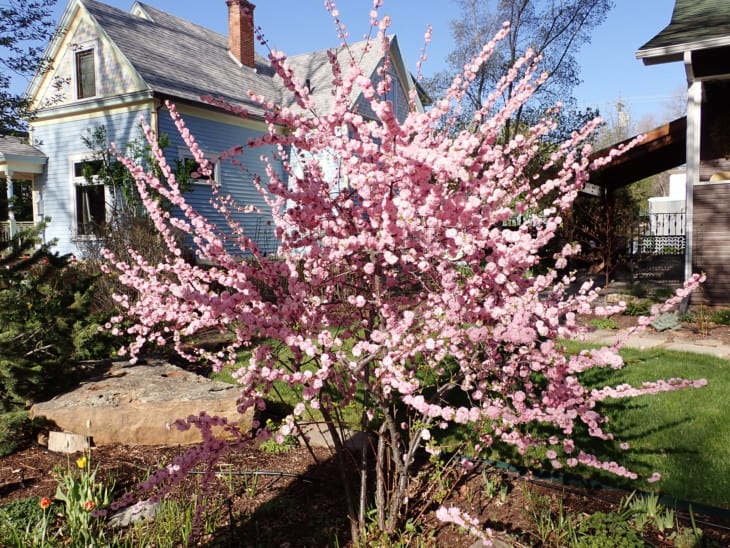
Flowering plums are small deciduous trees with purple leaves that are mostly utilized for decorative purposes. In full sun, they provide the finest foliage color and blossoming. They have beautiful dark red and purple foliage and produce a small, black fruit that ripens in late summer. They bloom with fragrant, showy flowers and grow up to 15 to 25 feet tall.
22. Saucer Magnolia (Magnolia × Soulangeana)
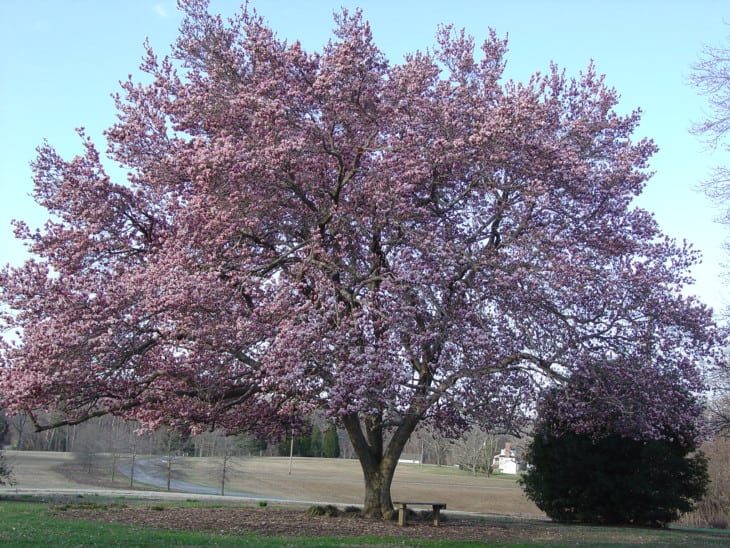
Saucer Magnolia is a deciduous tree with a refined and distinctive pyramidal shape, reaching a height of 30 feet with a spread of 30 feet at maturity. It blooms in early spring with lovely, aromatic, pink, cup-shaped flowers with white hues. It has huge, dark green, pointed leaves which turn a copper-bronze color in fall.
23. Serviceberry (Amelanchier arborea)
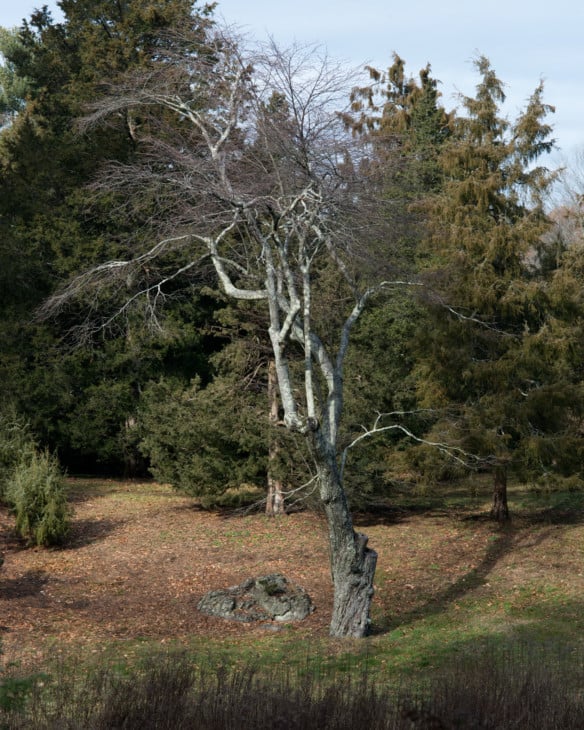
A small tree, the Serviceberry rarely reaches higher than 25 feet. Its gray bark breaks into shallow fissures on its short trunk. It features purplish-brown leaves, which mature to green leaves covered with silky hairs. It produces a sweet, round, dark purple fruit that ripens between July and August. Other than Wisconsin, it is native to Maine, Iowa, Florida, Louisiana, and South Carolina.
24. Pagoda Dogwood (Cornus alternifolia)
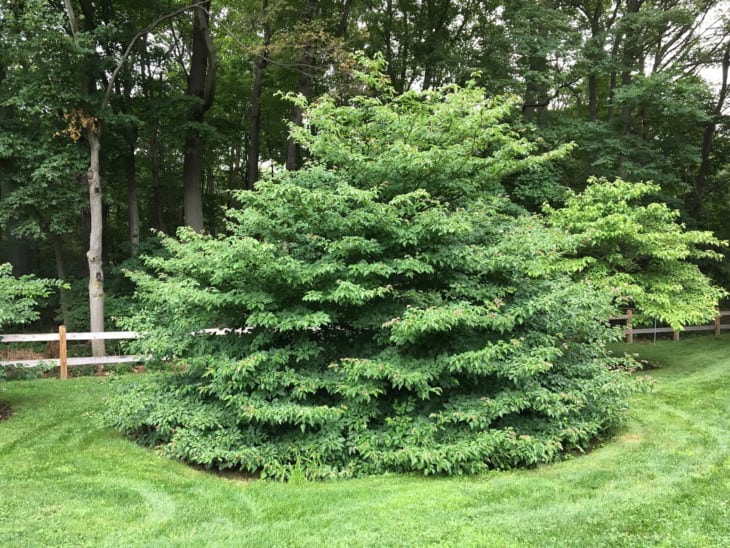
Pagoda Dogwood is a relatively small tree, growing between 15 to 25 feet, and is native to Wisconsin’s woodlands. It blooms in spring with 2-inch fragrant clusters of flowers with red stalks. Blue-black berries grow on the stalks in summer. Its green leaves turn a reddish-purple shade in the fall, creating a beautiful aesthetic appeal.
25. Red Cedar (Juniperus virginiana)
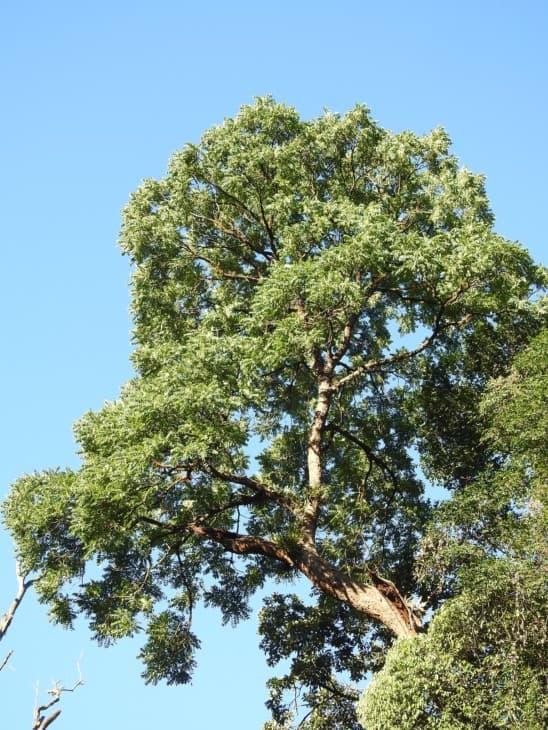
Red Cedar trees are commonly found on the limestone ridges in the state’s southwestern region. They grow to be 25 to 30 feet tall and have a pyramidical crown that can become rounded. The reddish-brown bark peels off in long, vertical strips and its leaves are dark green. The tree produces a dark blue berry-like cone that contains the tree’s seeds.

